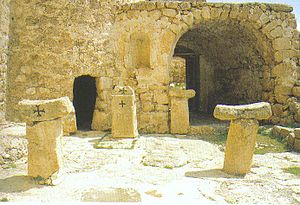Defence of Iwardo
The Defence of Iwardo (Syriac: ܥܝܢ ܘܪܕܐ - Iwardo or In wardo, Ayin Warda, Ain Wardo) was a military engagement between Ottoman authorities and Assyrian rebels led by Gallo Shabo in 1915, during the Assyrian genocide.[2][3]
| Defence of Iwardo | |||||||
|---|---|---|---|---|---|---|---|
| Part of the Assyrian genocide | |||||||
 | |||||||
| |||||||
| Belligerents | |||||||
| Asyrian/Syriac villagers and refugees |
Kurds | ||||||
| Commanders and leaders | |||||||
| Gallo Shabo |
Ahmed Agha Salem Agha | ||||||
| Strength | |||||||
| Between 6,000 to 7,000 villagers and refugees | 13,000 men | ||||||
| Casualties and losses | |||||||
| At least 1,000 deaths with both sides losses combined | |||||||
Background
Prior to the start of World War I, the village of Gülgöze had about 200 families, all of whom were ethnic Assyrians who belonged to the Syriac Orthodox Church. During the Assyrian Genocide, thousands of refugees from throughout Tur Abdin arrived there for safety. Refugees arrived from villages including Habasnos, Midyat, Bote, Keferze, Kafro Eloyto, Mzizah and Urnas. Even refugees from outside Tur Abdin arrived, coming from villages such as Deqlath, Bscheriye, Gozarto, Hesno d Kifo and Mifarqin. Between 6000 and 7000 Assyrians were gathered in the village.[4]
Once within the walls of Ayn-Wardo, the refugees were given water and food, and then assigned to defensive duties. The villagers were well prepared because they had realized when the First World War started that it would sooner or later be a threat to them. They had reinforced the walls around the village and armed themselves for war.[5]
Defense and battle
Being aware of the Turks and Kurds were coming to Gülgöze, the villagers and refugees created a militia to defend themselves, which was led by Gallo Shabo. Their resistance lasted 60 days, and ended in success.[6][7]
At the same time, the Kurdish authority of Midyat was given orders to attack Gülgöze and Arnas. However, Aziz Agha, the leader of the Midyat area, told them that they didn't have enough soldiers to attack both areas, and therefore they would attack Gulgoze only, and then go to Arnas later on. Therefore, The Kurds of Tur Abdin and Ramman, under the generalship of Ahmed Agha and Salem Agha, collected themselves in Mardin, and created a unit of 13,000 men. The government authorized the distribution of arms, and they headed towards Gülgöze, arriving late at night to begin the siege.
After hours of gun-battle, the Assyrians defeated the Kurds and drove them out, but there were many casualties on both sides regardless. After 10 days, The Kurds attacked again only to be beaten yet again, as they lost well over 300 men. Before the beginning of a third attempt, Kurdish leaders called for aid from the mayors of Diyarbakır(Raschid) and Mardin(Badri). However, A third attempt also failed and after 30 days of battle, Aziz Agha suggested a peace treaty between the two sides. 3 Assyrians met with Aziz to discuss a peace treaty, But the Assyrians refused to lay down their weapons, thus the battle continued. The siege continued for another 30 days leading to many deaths on both sides. In the end, the Kurdish soldiers surrendered and left the Assyrians of Tur Abdin alone, hence why the Tur Abdin region is one of the only Christian populated areas left in Turkey outside of Istanbul. The total death toll of this 60-day siege is unknown, but there were at least 1,000 deaths with both sides losses combined.[8]
References
- https://web.archive.org/web/20170417095929/https://www.svd.se/se-bilder-fran-platserna-dar-dramat-utspelade-sig#sida-6
- https://mirrorspectator.com/2018/11/08/prof-hannibal-travis-speaks-on-the-assyrian-armenian-greek-and-yezidi-genocides/ In 1915, explained Travis, Assyrians made resistance stands, such as in Ayn-Wardo (in today’s southeastern Turkey), against Turkish troops and Kurdish brigands — similar to that period’s Armenian defense stands in Van and at Musa Dagh
- https://site-media.bilda-cdn.nu/app/uploads/2018/10/11155249/in-times-of-genocide_webben.pdf The main Syriac town of Midyat had fallen after a week-long street-battle and the only other villages that still held out against the enemy was ‘Iwardo (now Gülgöze) just north of Midyat, Hah (now Anıtlı) further north-east of Midyat, and Basibrin (now Haberli) between Midyat and Azakh.
- https://www.svd.se/they-were-all-christians-and-therefore-had-to-die
- https://www.svd.se/they-were-all-christians-and-therefore-had-to-die
- https://www.atour.com/history/1900/20110520a.html
- Gaunt, David. Let Them Not Return: Sayfo – The Genocide Against the Assyrian, Syriac, and Chaldean Christians in the Ottoman Empire (War and Genocide). p. 164.
- Gaunt, David; Bet̲-Şawoce, Jan (1 January 2006). Massacres, Resistance, Protectors: Muslim-Christian Relations in Eastern Anatolia During World War I. Gorgias Press LLC. p. 348. ISBN 978-1-59333-301-0.